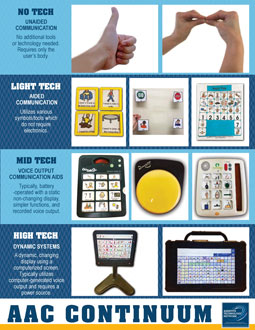Augmentative and Alternative Communication (AAC)
What is AAC?
Augmentative and alternative communication (AAC) includes all forms of communication (other than speech) that are used to express thoughts, needs, wants, and ideas. When we communicate we often use methods to either augment (add to) our message or as an alternative to speaking. Facial expressions, gestures, symbols, pictures, and writing are everyday examples of AAC forms.
Individuals with complex communication needs may rely on many forms of AAC. AAC can supplement existing speech or be a primary mode of communication. Using AAC may increase social interactions, participation in educational settings, community and work settings and overall expression and independence. AAC ranges from no tech to high tech supports and can be accessed in a variety of ways.

Downloadable version of AAC Continuum
"My daughter learned, from experience with well-intentioned professionals and us as her parents, that AAC is how we tell her what to say when we want her to say it. … It wasn't until we modeled a core word vocabulary across the day, echoing back to her what she was telling us (You are telling me to STOP. You are saying you're FINISHED. I can see you LIKE that!) that she began to believe that AAC could be HER voice, not mine."
There are many myths around AAC, the truth is that AAC can be used by anyone at any age to support communication. To learn more about some of the common myths related to AAC, check out this 2-minute video, 5 Common AAC Myths, by Life Skills 2 Learn.

